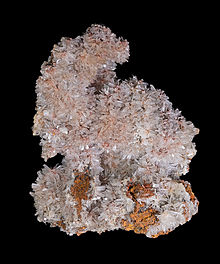Orthorhombic crystal system

The orthorhombic crystal system is one of the seven crystal systems in crystallography . It includes all point groups with three mutually perpendicular twofold rotational or rotational inversion axes. The orthorhombic crystal system is also called the rhombic crystal system. The term rhombic should not be confused with rhombohedral.
Point groups
The orthorhombic crystal system includes the point groups and . They form the orthorhombic crystal family and can be described with the orthorhombic grid system .
Grid system
The orthorhombic grid system has holoedry .
In the orthorhombic grid system, the grid axes lie in the direction of the 3 mutually perpendicular axes of symmetry. There are no further conditions for the length of the grid axes. This results in:
To determine which axis is a, b or c, there is only the condition that a right-handed coordinate system should be created. As a rule, the axes are chosen so that the Hermann Mauguin symbol corresponds to the standard of the International Tables for Crystallography . With the Hermann-Mauguin symbols, however, the room groups can be described with regard to any possible choice of axes. Since this happens more often, there is a tabular overview in the International Tables of all the options for describing a room group with any axis selection. It is therefore generally advisable to use the room group number when specifying the room group, as this makes it easier to find.
Bravais grid
There are four Bravais grids in the orthorhombic crystal system . In the standard setup, the b-centered grid does not appear and the a-centered grid only occurs in the point group . This is due to the fact that in this point group the grid system is set up in such a way that the twofold axis lies in the direction of the c-grid axis. Therefore it is not possible in all cases to place the grid axes in such a way that only the c-centered grid is used. The orthorhombic grid system is abbreviated with o.
Point groups in the orthorhombic crystal system and their physical properties
To describe the orthorhombic crystal classes in Hermann-Mauguin symbology , the symmetry operations are given with respect to three given directions (viewing directions) in the grid system. As in the monoclinic, the 3 viewing directions correspond to the a (<100>), b (<010>) and c grid axis (<001>). Since all three grid directions are directions of symmetry here, the Hermann-Mauguin short symbol also consists of three details.
It is characteristic of the orthorhombic space groups that there are no 3, 4 or 6 in the Hermann-Mauguin short symbol.
| Point group (crystal class) | Physical Properties | Examples | ||||||||||
|---|---|---|---|---|---|---|---|---|---|---|---|---|
| No. | Crystal system | Surname | Schoenflies icon | International symbol ( Hermann-Mauguin ) |
Tepid class | Associated room groups ( no.) |
Enantiomorphism | Optical activity | Pyroelectricity | Piezoelectricity ; SHG effect | ||
| Full | Short | |||||||||||
| 6th | orthorhombic | orthorhombic-disphenoidal | D 2 ( V ) | 222 | 222 | mmm | 16-24 | + | + | - | + |
Austinite epsomite |
| 7th | orthorhombic-pyramidal | C 2 v | mm 2 | mm 2 | 25-46 | - | + | + [001] | + |
Hemimorphite struvite |
||
| 8th | orthorhombic-dipyramidal | D 2 h ( V h ) | 2 / m 2 / m 2 / m | mmm | 47-74 | - | - | - | - |
Topaz anhydrite |
||
|
||||||||||||
For further orthorhombic crystallizing chemical substances see category: Orthorhombic crystal system .
literature
- Hahn, Theo (Ed.): International Tables for Crystallography Vol. A D. Reidel publishing Company, Dordrecht 1983, ISBN 90-277-1445-2
- D. Schwarzenbach Kristallographie Springer Verlag, Berlin 2001, ISBN 3-540-67114-5
- Will Kleber , Hans-Joachim Bautsch , Joachim Bohm , Detlef Klimm: Introduction to crystallography . 19th edition. Oldenbourg Wissenschaftsverlag, 2010, ISBN 978-3-486-59075-3 .
- Walter Borchard-Ott Crystallography 7th edition Springer Verlag, Berlin 2009, ISBN 978-3-540-78270-4









